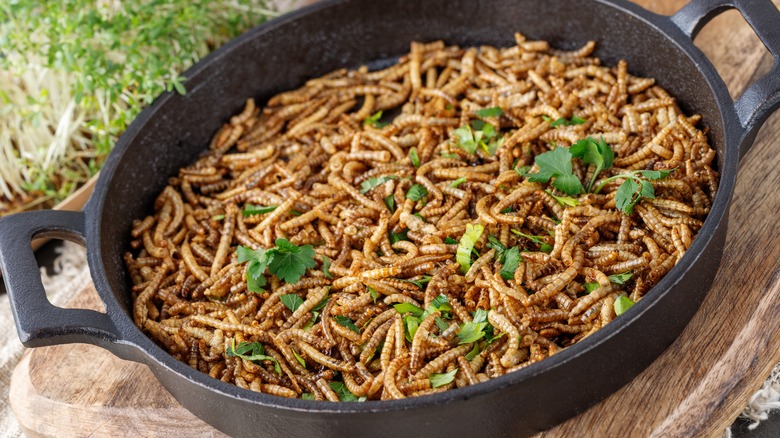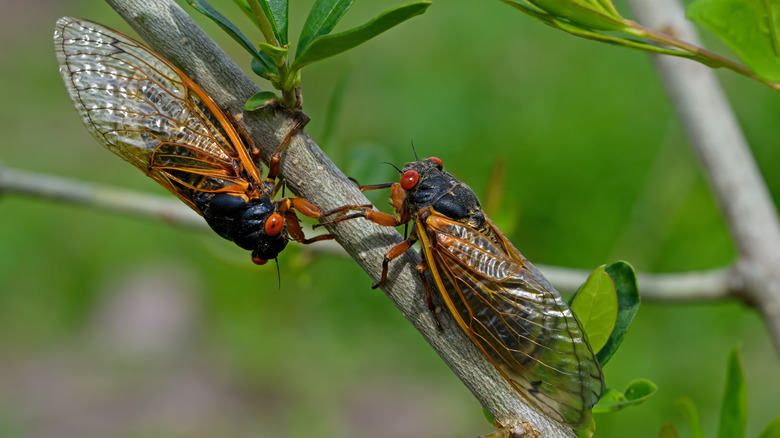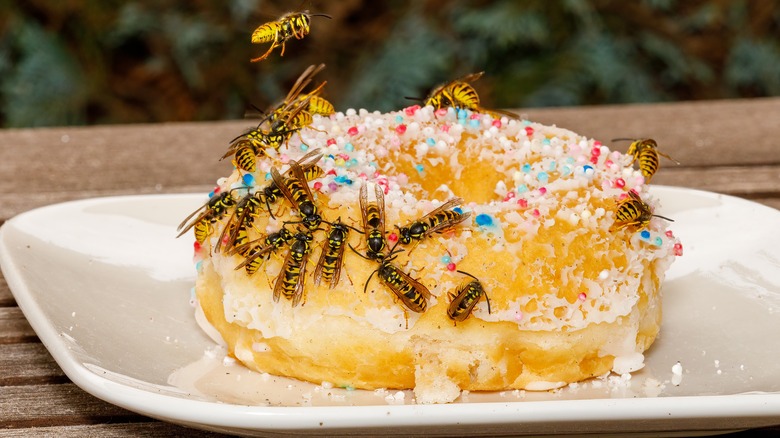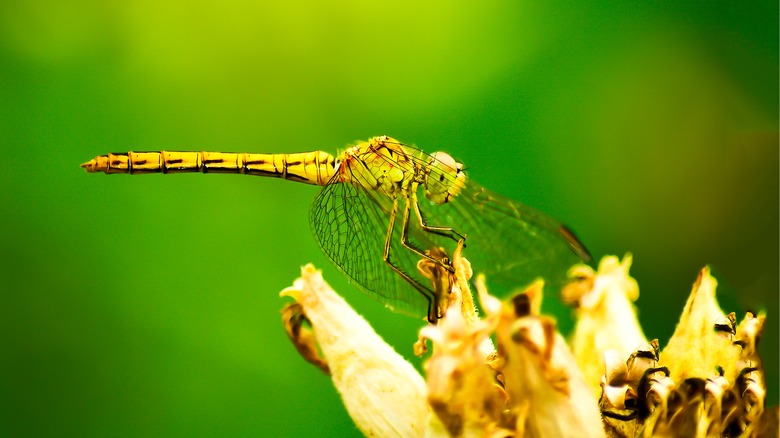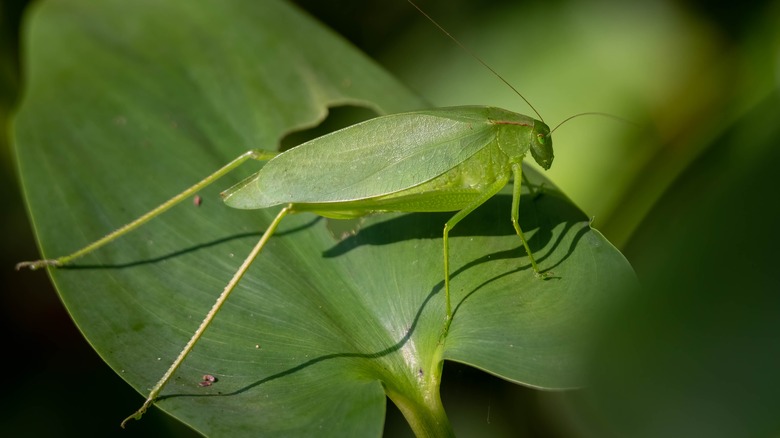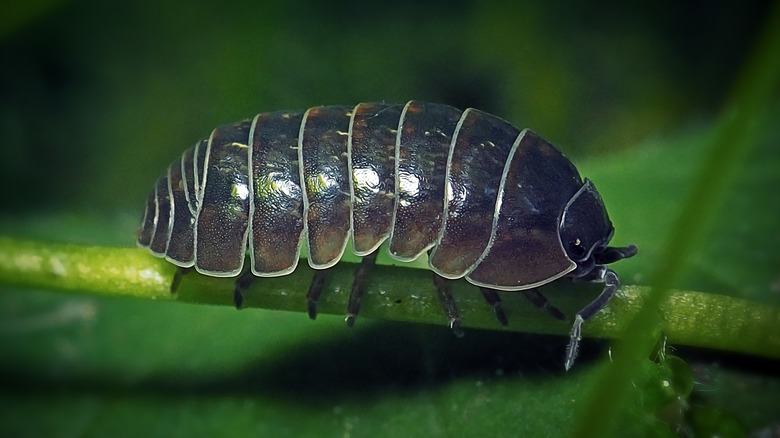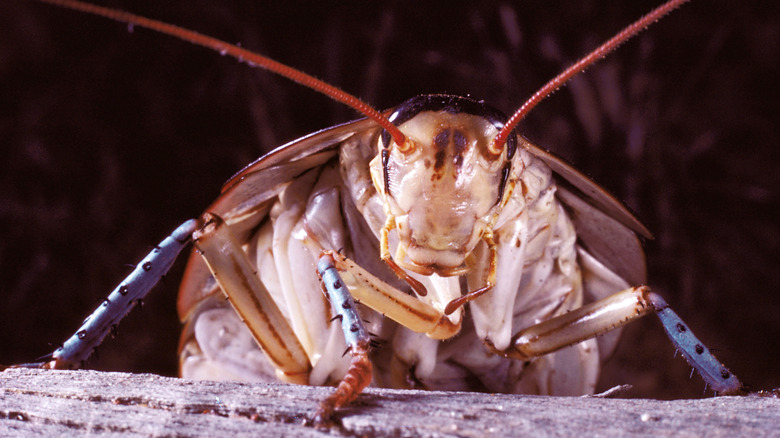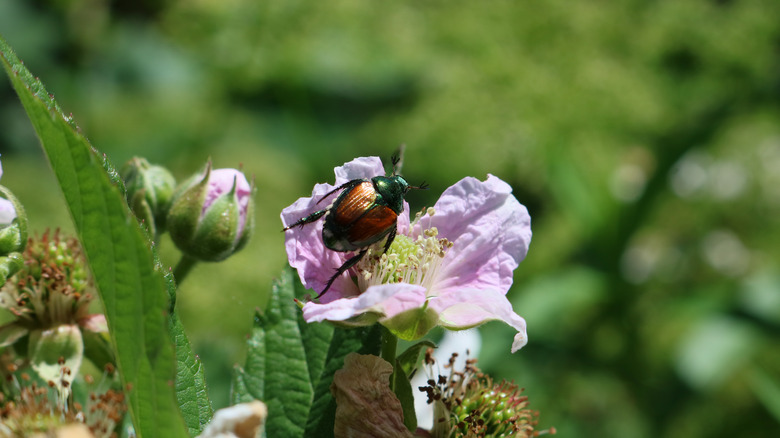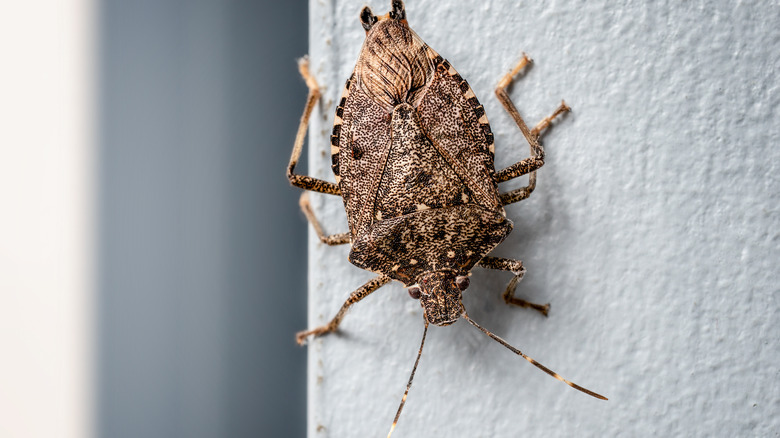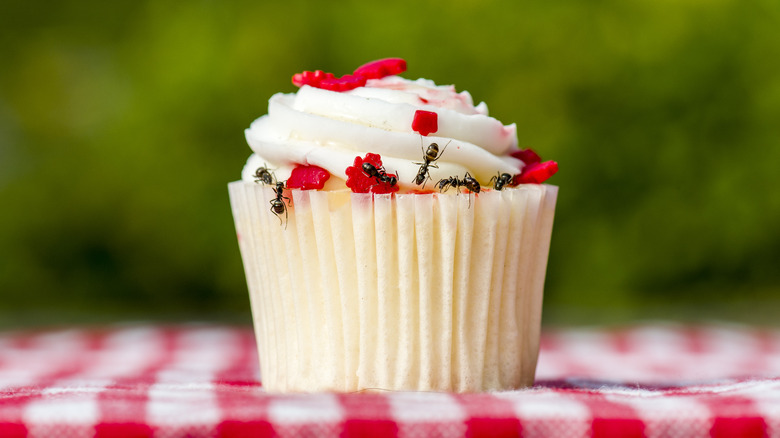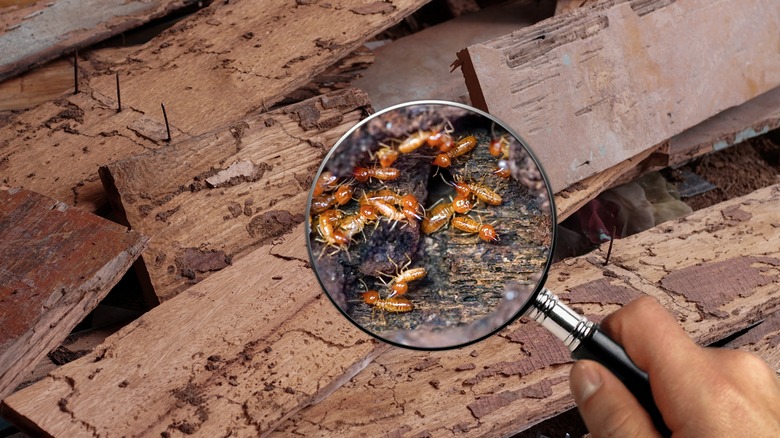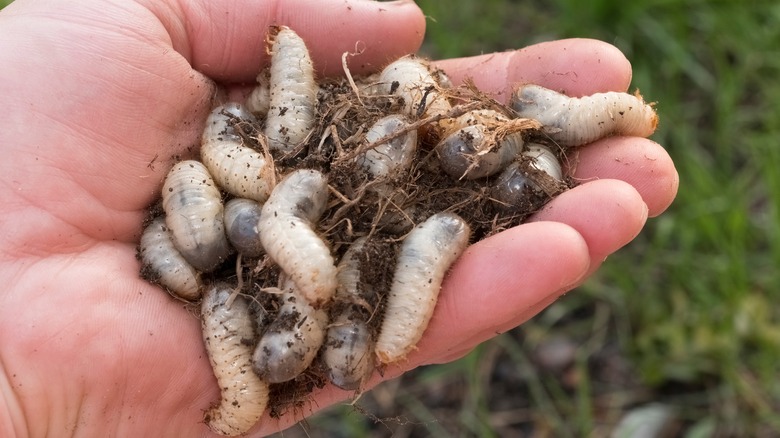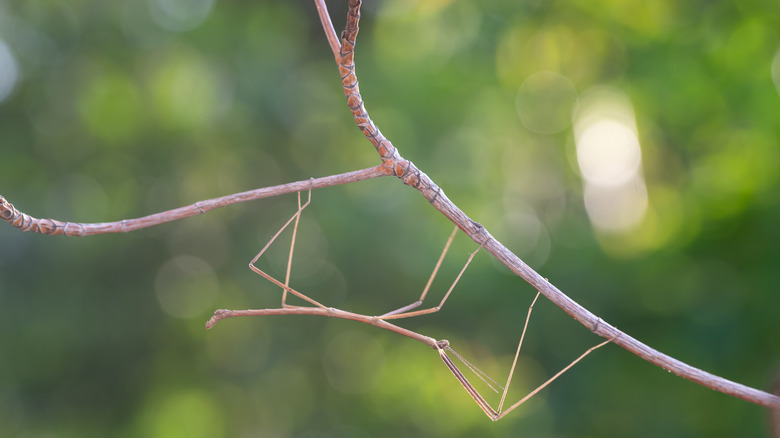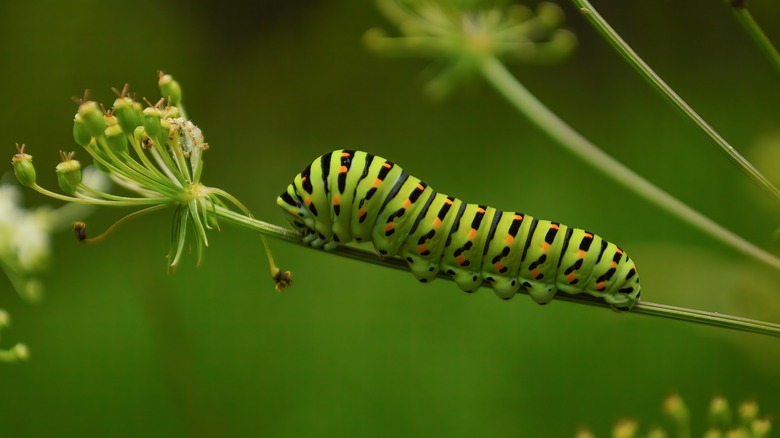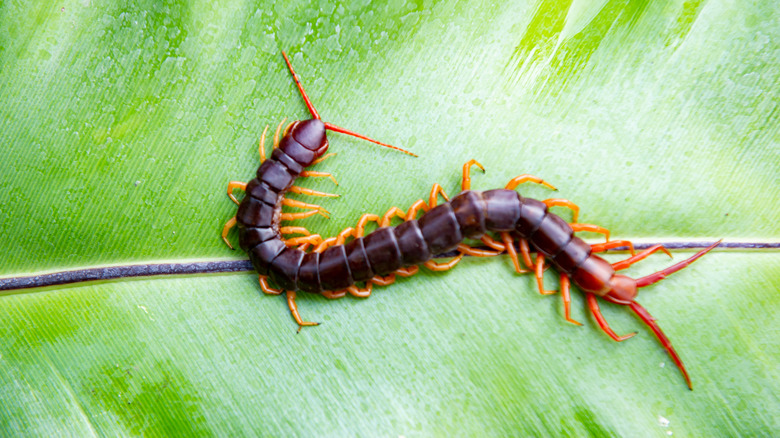16 Bugs That Are Safe To Eat In Case Of An Emergency When Camping
Eating insects is a common practice in many parts of the world and is often seen as a more sustainable way of living. However, plenty of people still want to keep bugs far away from their dinner plates. Those individuals would be pleased to learn they've likely eaten a few insects in their lifetime already. Food manufacturers are allowed a certain amount of insects, or insect parts, in their final, ready-to-consume products. This means there's always a chance a seemingly innocent snack includes more than meets the eye.
Thankfully, there are plenty of insects safe for human consumption, so eating them by accident isn't necessarily a bad thing. Many of them are packed full of high-quality nutrients that quite a few people could benefit from. But without accidentally eating them with a candy bar, how would someone know which ones are safe for consumption? In a situation where eating something like a creepy crawly critter could mean getting the essential nutrients needed for survival, it's important to know what insects won't cause major harm if ingested. Bon appétit.
Crickets
Possibly one of the most pleasant parts of camping is listening to the sounds of the world around you and allowing them to bring you closer to nature. There's music in the flow of a stream, the rustling of leaves, and the rhythmic chirp of breakfast. Or crickets. Or are they breakfast? Good news, they can be both.
Crickets are a popular source of food and are known for their nutty flavor profiles. One can get creative when cooking up some crickets and cook them, roast them, or bake them. They're rich in nutrients like fiber, protein, magnesium, zinc, and calcium. So crickets can be surprisingly good for your health, making them an ideal treat if you find yourself low on food in the wilderness. The best time for cricket hunting is in the early morning hours in grassy, warm areas.
Once you've captured enough crickets for a hearty breakfast, make sure you clean them and remove their legs prior to cooking, as their legs aren't edible. Another thing to note is that removing the cricket's head will do well at removing its entrails as well. Removing the entrails before cooking and eating a cricket will reduce your chances of obtaining a parasite with your meal.
Cicadas
You don't need to be in a pickle to enjoy a pickled cicada but know that if you do find yourself in one, cicadas are a safe bet to eat. These large insects are almost always easy to hear since they typically fill the outdoor air with the loud buzz for which they're known so well. Follow the buzz and likely these insects are hiding in trees or shrubbery. If cicada hunting after a storm, you may even find them resting on the ground.
Prep your cicada by removing the wings and legs as they're not safe for consumption. Boil any bacteria off the cicada and then cook to your liking. Cicadas can be cooked in many different ways including fried, baked, and boiled. Those who have an existing shellfish allergy should probably abstain from enjoying cicadas in their meals as cicadas are quite similar to shellfish and there's no concrete evidence one way or another whether someone would have a reaction from consuming one. Better safe than sorry.
Bees and Wasps
If you're out camping, backpacking, hiking, or doing anything else that may lead to you being outdoors with little to no food, and you can't seem to locate or catch any insects that won't sting you, you're in luck as there are insects you can consume that will sting you. Only if they're alive that is. Whether or not it sounds like an enjoyable experience, if necessary, bees and wasps can be used as a food source. In some countries, like Thailand, bees and wasps are considered a highly popular food source.
These insects may be trickier to eat since they need to be trapped first and their stingers removed. However, that luckily means you won't need to fear a sting after eating. If you're still unsure about eating something that, if alive, might try to cause you pain, you could always find and eat wasp larvae.
Most individuals who indulge in a bee or a wasp won't have any adverse side effects. Though for a select few there's always a risk of reaction possibly to pollen ingested along with the insect.
Locusts
Locusts aren't exactly favored by many, and farmers, in particular, may take issue with the destructive nature and appetite of these insects. Locusts are known to consume crops and vegetation, leaving little besides signs of chaos in their wake. They're not easy to stop either, especially when they swarm. However, if you can't beat 'em, you can certainly eat 'em.
Locusts can do wonders for someone struggling with hunger as they're packed with nutrients like protein, fiber, and carbohydrates. They even contain omega-3 and can help prevent heart disease. Humans frequently cook and eat locusts, and even use them as feed for livestock. Though they are known to be a healthy dietary addition, the exact vitamin content of a locust can vary based on that insect's region and diet. Most breeds of locusts can be harvested in large numbers during the night as they are typically active throughout the day. If you come across a swarm of locusts, you've hit the jackpot for food while exploring the outdoors.
Dragonfly
Dragonflies are insects that many enjoy admiring for their vibrant colors, unique look, and quick motions in flight. Another reason to praise the dragonfly is that it can help you out with a meal if you're ever in a pinch. As in, you can eat the dragonfly itself.
If you're up for snacking on a dragonfly or two, they aren't going to go down easy. Dragonflies are very fast and are difficult for even the most experienced insect catcher to capture once they start flying. For less of a challenge and workout, nymphs, or dragonfly larvae, are fairly simple to acquire. The adult dragonflies and their larvae can be found during the spring and summertime months in and around water sources. If you can catch an adult, the wings and the legs are edible as well as the rest of the dragonfly. However, they may be easier to swallow if you remove those pieces before eating. Be sure to cook the dragonflies or larvae to rid them of unwanted bacteria.
Katydids
The bush cricket, or katydid, has a distinct leaf-like appearance that helps them camouflage with the world around them. Though for those who know what they're looking for, they're not terribly difficult to find. They're usually hiding out in grassy areas or bushes. Depending on your location, they can be found in different terrains. In South America, a katydid can be found in the forest, whereas in North America, they're more likely to be found among the other creatures of the desert.
Katydids are already a snack of choice among many and are often distributed, cooked, and seasoned with various flavors. They don't just taste good, either. Katydids have been known to provide a plethora of health benefits, including the aid of ulcers and anemia. When looking for katydids, keep in mind they can get up to two and a half inches in size, and they do bite. Another thing to keep in mind is that they can carry parasites, so it's always best to cook them before you consume them.
Roly poly (pill bug)
They look like tiny potatoes that roll in a fun little ball. It's everyone's favorite bug, the roly-poly. Though, roly-polies roll in a ball as a form of self-defense. So it's likely they weren't having as much fun as everyone else. After providing generations worth of children with amusement, it turns out these little insects are good for more than just entertainment. They can be dinner, as well. Yup, if you're ever low on food, or just a curious explorer, it's good to know that you can eat a pill bug if you happen upon one.
Pill bugs are known in the world of entomophagy for their shrimp-like taste and high levels of protein. They're fairly easy to find hiding out underneath rocks or old logs. Look closely though, before grabbing on to eat as roly-polies look strikingly similar to a type of millipede called the pill millipede. These millipedes are just slightly smoother and rounder than a pill bug, but despite being similar in appearance, the pill millipede isn't edible.
Cockroach
If you've ever dealt with a pesky cockroach or two in your home, eating one might be considered sweet revenge. Or extremely off-putting. These insects are a common delicacy all around the world but when you remove the chili seasonings, the candy coatings, and the deep-fried cooking style, they're just a regular cockroach — but still edible.
Finding and eating a cockroach while on a hike or backpacking trip may come in handy as they're high in protein. They also work as a diuretic and are even considered by those who raise them to be medicinal for their ability to soothe ailments like a sore throat. Cockroaches are also packed with vitamins like zinc and vitamin B. Cockroaches should always be cooked before being eaten, and even though they're edible, it's not exactly recommended that a person eats any cockroaches they may find in their home. They're good for nutrients, but can also carry bacteria that cause Staphylococcus, a skin infection that in many cases is harmless, but in some situations can be serious and non-responsive to treatment.
June bug
For many campers, the June bug is the perfect insect to look for when looking for one to eat as, like many outdoor explorers, they're out during the spring and summer months when it's nice and warm. They won't be found as easily during the day as they are at night since they're nocturnal. So a flashlight or a headlamp may be a useful tool in finding them, especially because June bugs are attracted to light.
June bugs can be eaten as adults, or if you can find them, in larvae form. These insects feed on flowers and foliage, so look in these areas when tracking them down. They don't move quickly and are easy to catch, so as long as you have a light to attract them, chances are you'll catch plenty. It's recommended that June bugs be cooked before they're eaten. They're frequently grilled by those who eat them, but they'd probably taste the best as a meal cooked over a campfire.
Stink bug
These next insects are big fans of destroying crops. The stink bug thrives eating apples, beans, blueberries, tomatoes, and more. Eating these foods must come in handy, as when eaten by humans, stink bugs are loaded with B vitamins and even have pain-relieving capabilities.
These insects are often seen as pests and were first spotted in the United States in 1998 after being native to Asia and brought to the U.S. by mistake. The stink bug can be found in almost every state in the U.S., and though they're not group-dwelling insects, if you see one, you'll likely find many more as they're often gathered near the same food source in yards or homes. Their brown markings and shield-like shape make them easily identifiable, and they're incredibly easy to catch.
Some people choose to eat stink bugs while they're still alive as it's common for them to survive the cooking process. If you wish to remove the famous stink from the stink bug before eating it, soak it in water before boiling it or frying it up.
Ants
Ants are so attracted to campsites and human food sources that if you aren't careful, you may just eat them along with your next outdoor meal anyway. It's not all bad if you wind up eating an ant or two by mistake, as they're typically high in protein, fiber, and other essential vitamins. It may take a large amount of ants to feel full, especially if you're in a situation of being without food for a long period. Thankfully, if you spot one ant, it's almost always guaranteed there's plenty more where it came from. This is why they're a great food source in an emergency situation.
There's little research or evidence on the downsides of eating ants. However, they're considered an environmentally friendly source of protein and are often enjoyed as ingredients or whole. In some places, ants are used to treat sore throats and asthma. Their heads have even been used as stitches to close up wounds. Make sure to avoid specific ants like fire ants when looking for some to eat, and if possible, try to cook your ants before consumption.
Termites
If you're in a survival situation, eating termites is an excellent way to give your body what it needs to keep going. Termites contain up to 38% protein, which in some cases is more protein than one would get from eating a standard meat diet. Termites have a high iron and calcium content as well, and they're filled with fatty and amino acids. Much like ants and other insects, if you locate a termite, it's safe to assume there's an abundance of them nearby.
These insects are often considered pests who wreak havoc on people's homes, but when exploring the great world outside, far from the standard American suburb, these guys are typically found in nests underground or in dead trees and stumps. You don't have to be an expert to catch termites either. Ideally, termites should be washed several times and cooked prior to consumption, but if the situation calls for it, one could help themselves to a termite buffet out in the woods.
Grub and larvae
Timon and Pumbaa had the right idea with their love of eating grubs in "The Lion King." Grubs and larvae are the perfect dietary choice for someone in an emergency situation with little to no food on hand because of their high protein content. Grubs are just the larvae stage of different beetles and can be found in dark, wet places like in rotting logs or under rocks.
Both grub and larvae should be rinsed before eating, and if you're in a position to make a fire, they can be roasted on a stick until they're crispy on the outside. When cooked, grub and larvae are said to have a nutty flavor profile and chewy texture. It's their desirable flavor that makes grub a popular food choice in many cultures. Grub can be, and are often eaten outside of survival situations as well, and are frequently sauteed in a pan and seasoned with a variety of spices.
Walking stick
A little tricker to find, the walking stick is another perfectly edible insect if need be. You may have to squint your eyes and really focus on the trees and shrubbery, as the walking stick is a master of camouflage and blends in with its surroundings, mainly sticks perfectly, hence its name. Once you find one, walking sticks are easily caught as they don't move quickly and they aren't equipped with stingers.
One of the great things about finding these masters of disguise is that not only will they make a high protein, nutrient-rich snack, but they're versatile in their usefulness. Most of the walking stick can be cooked and eaten and the legs make the perfect tool to catch fish. So once you've got the initial energy from eating the walking stick, it will continue to provide you with even more food from the water — making your emergency or survival situation just a little easier to bear.
Earthworms
This one might feel like a throwback to a childhood playground or even an episode of "Goosebumps," but earthworms are a great place to start if you're looking for a quick meal. Most known species of worms are safe for human consumption and they aren't lacking in the vitamin department. Earthworms are high in protein, iron, and amino acids. They're also full of calcium, magnesium, and zinc. All of these are essential nutrients regularly, but even more so if you've gone longer than usual without a meal. It's fairly easy to dig them up, or you may even see a spike in earthworms after it rains.
In many parts of the world, worms are raised with human consumption in mind, meaning their diets are monitored and free of the usual worm-like diet, which can include substances that may be harmful to humans. Earthworms are widely regarded as a sustainable food source and growing in popularity. Out amid mother nature, you may not be able to hand-pick a worm's diet before eating it, but at least you can be sure you're getting precious nutrients to keep yourself going.
Moth and butterfly larvae
Caterpillars are possibly the cutest insects scrunching along through the great outdoors, and if you happen to find one when your stomach is empty, they can be a nice snack too. Along with caterpillars, moth larvae can also be consumed. Moths and butterflies are common insects that often garner opposite opinions from people regarding their creepiness levels, but in an emergency, both of their larvae stages will provide sustenance.
Be wary though and don't get so hungry that you allow yourself to eat the adult moths or butterflies. Their wings are covered in a layer of hair and scales that will act as an irritant when swallowed. The larvae stages should provide a healthy amount of fat, protein, and nutrients to help you get out of an emergency situation or get the help you need. These insects can be found in tall grass, shrubs, and low tree branches. If possible, try to clean and cook these insects before eating them.
A word of caution
Venturing into the outdoors can be an exhilarating experience. However, things can take a turn quickly, and if food becomes scarce, desperation can set in. Knowing what is and isn't safe for consumption is a good skill to have, and being brave enough to try new things could be a necessary trait in a sticky situation.
Not all insects are edible though. Some, like the centipede (pictured above), aren't safe for human consumption. Even insects that are safe should always be cleaned and cooked if possible before being eaten in order to avoid getting sick or picking up a parasite that could cause issues down the line. Generally, if the insect has a crunchy exoskeleton, it's safe to eat. On the other hand, vibrant colors on an insect typically indicate they aren't safe for consumption and that they'll make you sick. Making an already difficult situation in the wilderness, even worse. So exercise caution, but you never know, you may just find a new favorite food.
